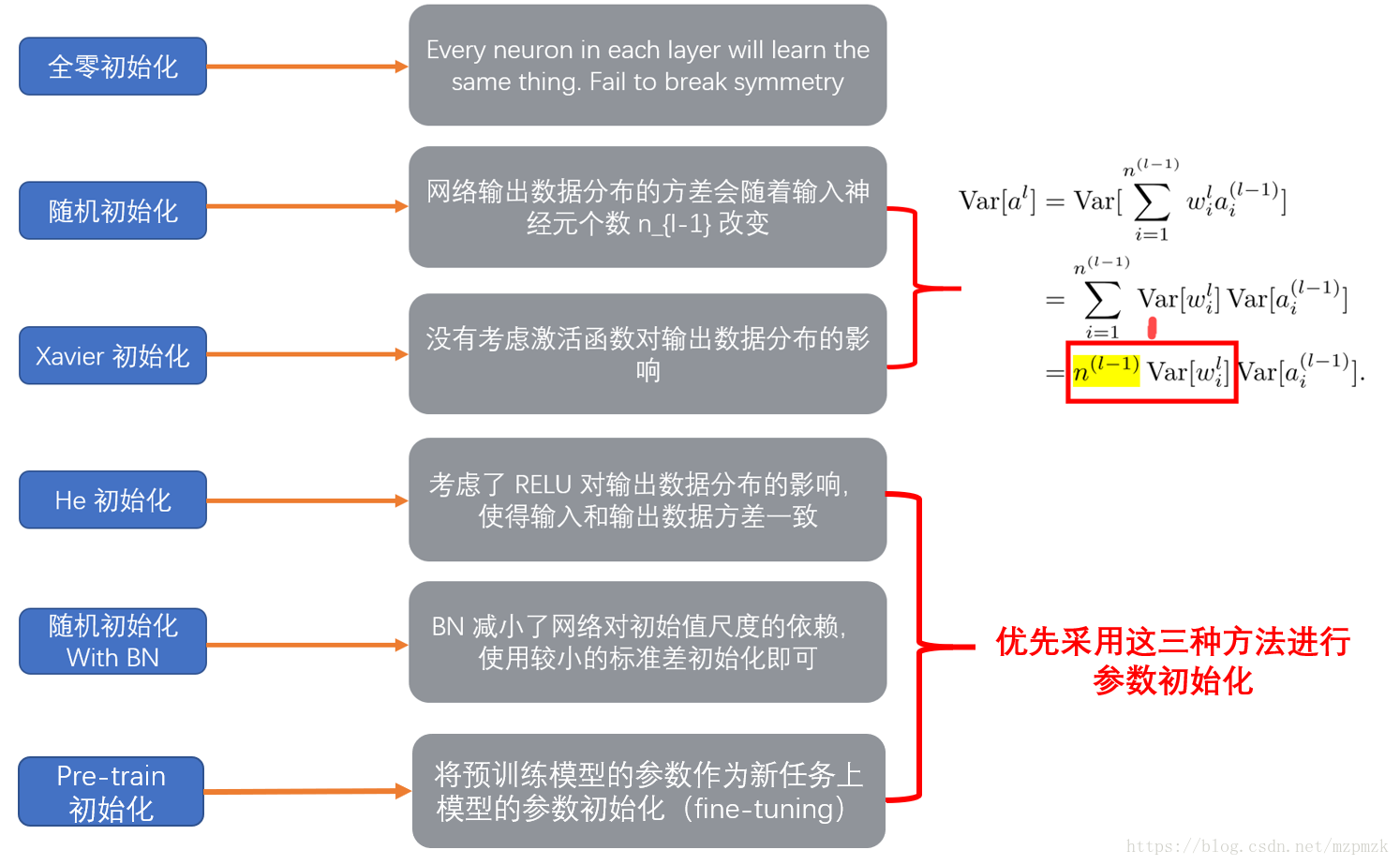权重初始化
模型权重的初始化对于网络的训练很重要, 不好的初始化参数会导致梯度传播问题, 降低训练速度; 而好的初始化参数, 能够加速收敛, 并且更可能找到较优解. 如果权重一开始很小,信号到达最后也会很小;如果权重一开始很大,信号到达最后也会很大。不合适的权重初始化会使得隐藏层的输入的方差过大,从而在经过sigmoid这种非线性层时离中心较远(导数接近0),因此过早地出现梯度消失.如使用均值0,标准差为1的正态分布初始化在隐藏层的方差仍会很大. 不初始化为0的原因是若初始化为0,所有的神经元节点开始做的都是同样的计算,最终同层的每个神经元得到相同的参数.
好的初始化方法通常只是为了增快学习的速度(加速收敛),在某些网络结构中甚至能够提高准确率.
下面介绍几种权重初始化方式.
- 初始化为
小的随机数,如均值为0,方差为0.01的高斯分布:
W=0.01 * np.random.randn(D,H)然而只适用于小型网络,对于深层次网络,权重小导致反向传播计算中梯度也小,梯度"信号"被削弱. - 上面1中的分布的方差随着输入数量的增大而增大,可以通过正则化方差来提高权重收敛速率,初始权重的方式为正态分布:
w = np.random.randn(n) / sqrt(n). 这会使得中间结果(z=sum_i w_ix_i+b)的方差较小,神经元不会饱和,学习速度不会减慢.
论文 Delving Deep into Rectifiers: Surpassing Human-Level Performance on ImageNet Classification by He et al. 中阐述了ReLU神经元的权值初始化方式,方差为2.0/n, 高斯分布权重初始化为:w = np.random.randn(n) * sqrt(2.0/n), 这是使用ReLU的网络所推荐的一种方式.
论文[Bengio and Glorot 2010]: Understanding the difficulty of training deep feedforward neuralnetworks 中推荐使用 ( ext{Var}(W) = frac{2}{n_ ext{in} + n_ ext{out}}). - Xavier (均匀分布)
- MSRA
上述初始化方式的1,2仅考虑每层输入的方差, 而后两种方式考虑输入与输出的方差, 保持每层的输入与输出方差相等. 2,4 方法中针对ReLU激活函数, 放大了一倍的方差.
Xavier权重初始化
Xavier初始化可以帮助减少梯度弥散问题, 使得信号在神经网络中可以传递得更深。是最为常用的神经网络权重初始化方法。
算法根据输入和输出神经元的数量自动决定初始化的范围: 定义参数所在的层的输入维度为n,输出维度为m,那么参数将从([-{sqrt{6over m+n}},{sqrt{6over m+n}}])均匀分布中采样。
公式推导
假设输入一层X,输出一层Y,那么
按照独立变量相乘的方差公式,可以计算出:
我们期望输入X和权重W都是零均值,因此简化为
进一步假设所有的(X_i,W_i)都是独立同分布,则有:
即输出的方差与输入有关,为使输出的方差与输入相同,意味着使(n ext{Var}(W_i)=1).因此( ext{Var}(W_i) = frac{1}{n}=frac{1}{n_{in}}).
如果对反向传播的梯度运用同样的步骤,可得:( ext{Var}(W_i) = frac{1}{n_ ext{out}}).
由于(n_{in},n_{out})通常不相等,所以这两个方差无法同时满足,作为一种折中的方案,可使用介于(frac{1}{n_{in}},frac{1}{n_{out}})之间的数来代替:简单的选择是( ext{Var}(W_i) = frac{2}{n_ ext{in} + n_ ext{out}}).
可以根据均匀分布的方差,反推出W的均匀分布:
由于 [a,b] 区间的均匀分布的方差为:( ext{Var}={(b-a)^2over 12}),使其零均值,则b=-a,所以( ext{Var}={(2b)^2over 12}=frac{2}{n_ ext{in} + n_ ext{out}}),可得(b={sqrt{6}over sqrt{n_{in}+n_{out}}}).
因此,Xavier初始化的就是按照下面的均匀分布(uniform distribution):
xavier权重初始化的作用,使得信号在经过多层神经元后保持在合理的范围(不至于太小或太大)。
caffe当前的xavier实现代码:
/* 输入blob的shape:(num, a, b, c)对应(输出channel,输入channel,b*c=kernel size)
扇入 fan_in = a * b * c
扇出 fan_out = num * b * c
scale = sqrt(3 / n) 这里的n根据参数决定:fan_in, fan_out, 或着平均。
这里的sqrt(3 / n)中当n=(n_j + n_{j+1})/2时就是上面式子中的$sqrt{6}/sqrt{n_j + n_{j+1}}.
然后用[-scale,scale]的均匀分布随机采样初始化权重
*/
template <typename Dtype>
class XavierFiller : public Filler<Dtype> {
public:
explicit XavierFiller(const FillerParameter& param)
: Filler<Dtype>(param) {}
virtual void Fill(Blob<Dtype>* blob) {
int fan_in = blob->count() / blob->num();
int fan_out = blob->count() / blob->channels();
Dtype n = fan_in;
if (this->filler_param_.variance_norm() ==
FillerParameter_VarianceNorm_AVERAGE) {
n = (fan_in + fan_out) / Dtype(2);
} else if (this->filler_param_.variance_norm() ==
FillerParameter_VarianceNorm_FAN_OUT) {
n = fan_out;
}
Dtype scale = sqrt(Dtype(3) / n);
caffe_rng_uniform<Dtype>(blob->count(), -scale, scale,
blob->mutable_cpu_data());
}
};
MSRA Filler
上边所提的初始化方式为使每层方差一致,从而不会发生前向传播爆炸和反向传播梯度消失等问题。对于ReLU激活函数,其使一半数据变成0,初始时这一半的梯度为0,而tanh和sigmoid等的输出初始时梯度接近于1.因此使用ReLU的网络的参数方差可能会波动。论文Delving Deep into Rectifiers: Surpassing Human-Level Performance on ImageNet Classification,Kaiming He中提出使用( ext{Var}(W) = frac{2}{n_ ext{in}})放大一倍方差来保持方差的平稳。
前向和后向推导的方差均控制在({2over n}),综合起来使用均值为0,方差为(sqrt{4over n_{in}+n_{out}})的高斯分布.
caffe MSRA Filler实现代码:
/**
* Fills a Blob with values $ x sim N(0, sigma^2) $
* A Filler based on the paper [He, Zhang, Ren and Sun 2015]:
* Specifically accounts for ReLU nonlinearities.
*/
template <typename Dtype>
class MSRAFiller : public Filler<Dtype> {
public:
explicit MSRAFiller(const FillerParameter& param)
: Filler<Dtype>(param) {}
virtual void Fill(Blob<Dtype>* blob) {
CHECK(blob->count());
int fan_in = blob->count() / blob->num();
int fan_out = blob->count() / blob->channels();
Dtype n = fan_in; // default to fan_in
if (this->filler_param_.variance_norm() ==
FillerParameter_VarianceNorm_AVERAGE) {
n = (fan_in + fan_out) / Dtype(2);
} else if (this->filler_param_.variance_norm() ==
FillerParameter_VarianceNorm_FAN_OUT) {
n = fan_out;
}
Dtype std = sqrt(Dtype(2) / n);
caffe_rng_gaussian<Dtype>(blob->count(), Dtype(0), std,
blob->mutable_cpu_data());
CHECK_EQ(this->filler_param_.sparse(), -1)
<< "Sparsity not supported by this Filler.";
}
};
bias初始化
通常初始化为0(若初始化为0.01等值,可能并不能得到好的提升,反而可能下降)
Batch Normalization
在网络中间层中使用 Batch Normalization 层一定程度上能够减缓对较好的网络参数初始化的依赖,使用方差较小的参数分布即可. 参考论文 Batch Normalization。
总结
- 当前的主流初始化方式 Xavier,MSRA 主要是为了保持每层的输入与输出方差相等, 而参数的分布采用均匀分布或高斯分布均可.
- 在广泛采用 Batch Normalization 的情况下, 使用普通的小方差的高斯分布即可.
- 另外, 在迁移学习的情况下, 优先采用预训练的模型进行参数初始化.

参考